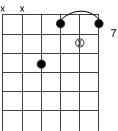The Tao is an ever expanding list of thoughts, ideas, techniques and mindsets to be applied to the art and craft of accompaniment. New additions to the list are added to the top, so you only have to scroll down to review.
Or, to get to the comments part where you can suggest some additions.
Like all good dogmas, this Tao should have a variety of inputs from many points of view. If some of the suggestions are diametrically opposed to others, so be it. Internal contradictions are not only acceptable, they are an important feature of any well subscribed set of beliefs.
- Never play two notes when one will do the job
- Never play three notes when two will do
- And so on… Become a good editor of your playing. It’s better to have a musician you’re accompaning ask you to play a little more than to have them tell you to play a little less. Think of it like a big old chestnut tree in the middle of a pasture. That’s the one that gets noticed, the one the photographers take the picture of in every season. It’s the part of the landscape that frames the cattle and emphasizes the openness of the pasture. If there were ten it would just be a bunch of trees. If there are two or three that have symmetry or complement each other it is good. But if it is just the right one for that pasture at that time…
- It is remarkably difficult to accomplish 1, 2, and 3 on a consistent basis. It is remarkably easy to play too many notes. You have to practice and play a lot to develop the knowledge, the chops and the confidence to play sparingly. It is the great paradox of being an accompanist. There are many great musicians whose early career was defined by their technical ability, speed and ferocious attack. As the best of these players continue to grow and progress they tend to play fewer and fewer notes, but each one expresses more.
- A note is not just the pitch. It’s the attack, the tone, the duration, the vibrato, the coloring by where you play it on the fretboard. All these things and more define the note, consider them all.
- Learn chord inversions so you can play any chord anywhere on the guitar. For instance, this is a four note G major chord played at the 7th fret:
The dot with the ‘X’ represents the root tone, the ‘G’ in this case. When the song has a G chord, you can play it here to add a little color to the sound. You can use this chord shape for any major chord as long as you know where the root tone is on the second string. Move it two frets higher and it’s an ‘A’ chord. Two frets down and it’s an F chord.
- Arpegiating these inversions is a subtle way to accent the harmony behind the vocal.
- Add another tone to the arpeggio for color – a ninth or a sixth for example.
- Seldom, if ever, play a line over a vocal phrase. A single sustained note or two notes together works well. A complementary rhythmic figure will work as well.
